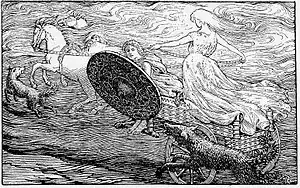
Svalinn is a legendary shield in Nordic mythology which stands in front of Sun, protecting the world from her heat. It has been suggested to be part of a continuous tradition of solar imagery dating back to the Nordic Bronze Age.
Etymology
Svalinn in Old Norse translates as "cold" or "chill" and is derived from the verb svala, meaning "to cool", in turn from the adjective Old Norse: svalr ('cool'), from Proto-Germanic: *swalaz from Proto-Germanic: *swelaną ("to burn slowly, create a burningly cold sensation") from Proto-Indo-European: '*swel-' ("to shine, warm up, burn").[1][2][3]
Attestations
Grímnismál
In Grímnismál, Odin gives the role of Svalinn as part of his description of the cosmology:
| Old Norse text[4] | Orchard translation[5] | Bellows translation[6] | Dronke translation[7] | |
|---|---|---|---|---|
|
|
|
|
Nafnaþulur
In the Nafnaþulur section of the Prose Edda, Snorri Sturluson records Svalinn in a list of shields:
| Old Norse text[8] | Ingham translation[9] |
|---|---|
|
|
Sigrdrífumál
In Sigrdrífumál, runes are described as being carved on a shield, identified with Svalinn, along with the horses that draw Sun's chariot.[10]
| Old Norse text[8] | Orchard translation[11] |
|---|---|
|
|
Interpretation and symbolism

The association between the sun and shields is noted both in Þórsdrápa, in which the sun is described as 'the splendid sky-shield',[12][note 1] and in Skáldskaparmál, in which a kenning for 'shield' is the "sun of the ship" (Old Norse: skipsól). This relationship between ships, shields and the sun has been suggested to originate in the Nordic Bronze Age, in which all three form part of the sun myth.[13] Ritual shields dating to the Bronze Age have also been discovered in Scandinavia which have been noted by scholars to resemble the sun and were possibly used to represent it in a religious context.[14]
In the Nordic Bronze Age, the sun could be depicted as a wheel cross or a disc, as with the Trundholm sun chariot. It has been argued that the disc later ceased to be seen as a representation of the sun god herself and instead as it appears in the sky, as a round shield. By this theory, the role of the shield in preventing the world from overheating came later to explain its presence.[15]
See also
- Hou Yi—archer in Chinese mythology who saved the world from the heat of suns
- List of mythological objects
- Sun deity
Explanatory notes
Citations
- ↑ Wang 2017, p. 23.
- ↑ svala.
- ↑ svalr.
- ↑ Grímnismál (ON), Stanza 37 & 38.
- ↑ Orchard 2011, p. 56, Grímnismál: The lay of Grímnir, stanza 37 & 38.
- ↑ Bellows 2004, Grimnismol stanza 37 & 38.
- ↑ Dronke 2011, The Lay of Grimnir, stanza 37 & 38.
- 1 2 Nafnaþulur (ON), Stanza 58.
- ↑ Ingham, Stanza 58.
- ↑ Orchard 2011, Notes, Sigrdrífumál: Sigrdrífa's lay (15).
- ↑ Orchard 2011, Sigrdrífumál: Sigrdrífa's lay, stanza 15.
- 1 2 Gade 2017, p. 85.
- ↑ Wang 2017, p. 25.
- ↑ Wang 2017, p. 6.
- ↑ Branston 1980, p. 69.
References
Primary
- Bellows, Henry Adam (2004). The Poetic Edda: The Mythological Poems. Mineola, NY: Dover Publications. ISBN 9780486437101.
- Dronke, Ursula (2011) [1969]. The Poetic Edda. Oxford: Clarendon Press. ISBN 9780198111825.
- Gade, Kari Ellen (2017). Poetry from Treatises on Poetics. Turnhout, Belgium: Brepols Publishers. ISBN 9782503518947.
{{cite book}}:|website=ignored (help) - Ingham, Marion. Viðauki I: Nafnaþulur.
- Orchard, Andy (2011). The Elder Edda: A Book of Viking Lore. London: Penguin Books. ISBN 9780141393728.
- "Grímnismál (Old Norse)". heimskringla.com. Retrieved 25 September 2022.
- "Nafnaþulur (Old Norse)". heimskringla.no. Retrieved 26 September 2022.
Secondary
- Branston, Brian (1980). Gods of the North. London: Thames and Hudson.
- Wang, Lanchun (2017). Freyja and Freyr: Successors of the Sun: On the Absence of the Sun in Nordic Saga Literature. Oslo: Universitetet i Oslo. S2CID 55929363.
- "svala". Wiktionary. 3 July 2022. Retrieved 26 September 2022.
- "svalr". Wiktionary. 5 January 2022. Retrieved 26 September 2022.